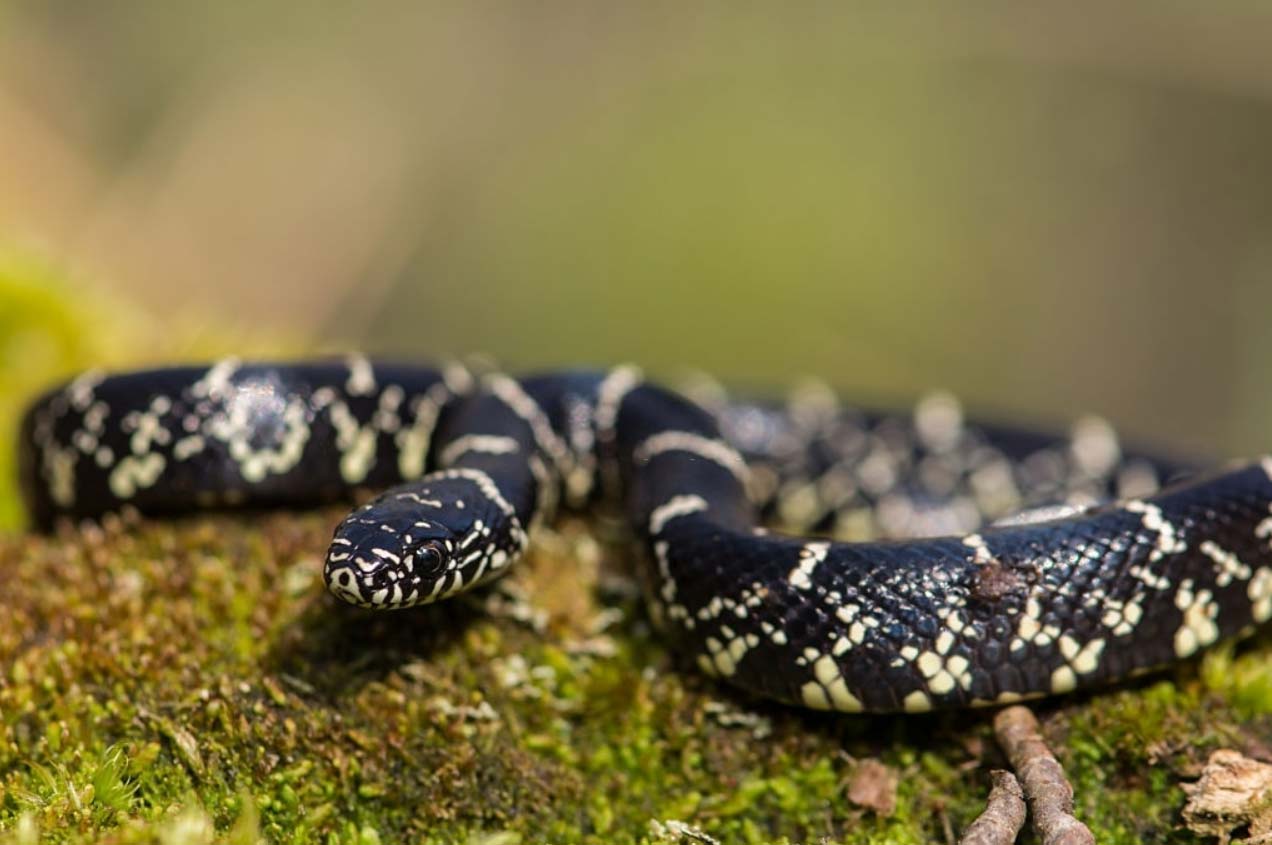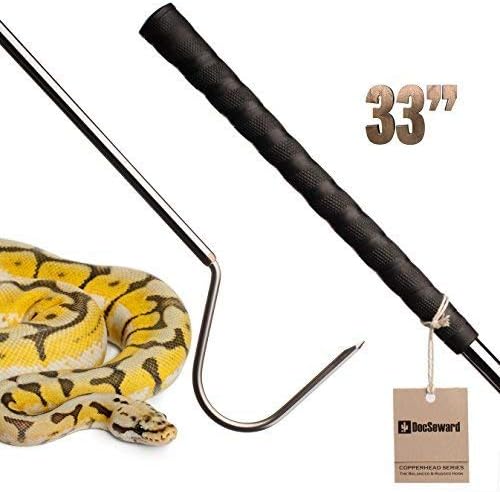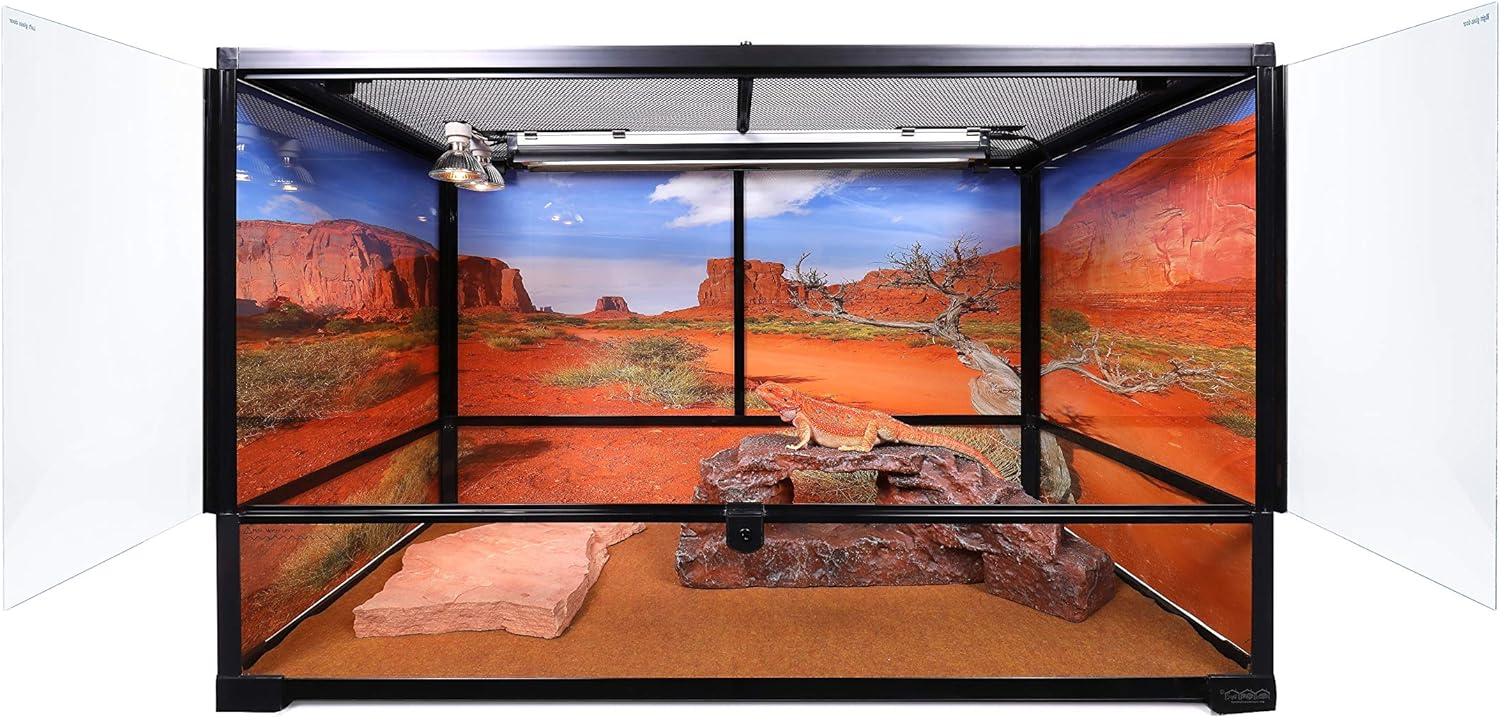Despite its larger size and enclosure requirements, the Eastern Kingsnake (Lampropeltis getula getula) has developed a dedicated following.
This snake’s laidback temperament after maturity and easy feeding habits make it a favorite among beginners and experts alike.
Combined with its beautiful coloring and active behaviors, it’s unsurprising that so many reptile owners recommend the Kingsnake.
| Common Name | Eastern Kingsnake |
| Scientific Name | Lampropeltis getula getula |
| Natural Habitat | North America |
| Adult Size | 3 – 5 ft. |
| Lifespan | 15 – 25 years |
| Diet | Small reptiles, mammals, birds, and amphibians |
| Experience Level | Beginner – Expert |
| Enclosure Size | 20 – 40 gallons |
Reptile Overview
The Eastern Kingsnake (Lampropeltis getula getula) is native to North America and can be found anywhere from Mexico to New Jersey.
In the wild, it has a distinctive black coloring with a chain pattern.
With a lifespan of more than 20 years and a body more than three feet long, the Kingsnake is only for owners ready for a long-term commitment.
But for those who are interested, the Eastern Kingsnake is a worthwhile investment. Their docile temperament is matched by their similarly laidback feeding style and straightforward care requirements.
These active snakes continuously amuse their owners. They love exploring their enclosures— especially those that mimic their natural habitat— and can quickly grow to love their owners just as much.
Appearance
The Eastern Kingsnake’s native coloring features glossy black or dark brown scales with yellow or white rings. The rings connect along the snake’s side, creating a sort of chain-like pattern.
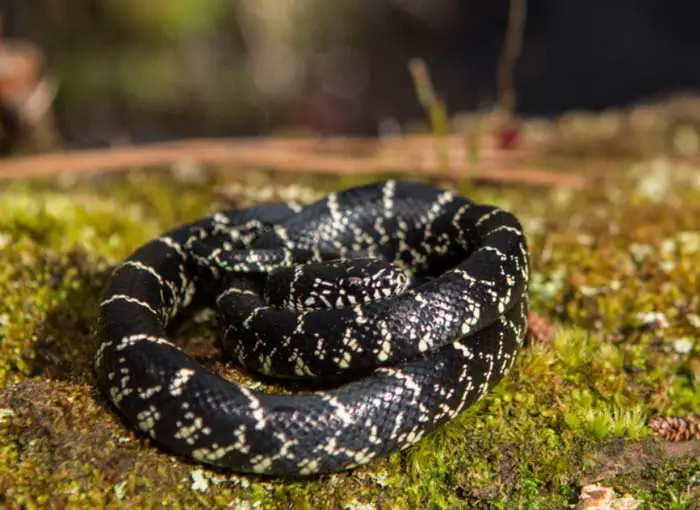
However, their burgeoning popularity has led to more diverse color patterns. Since it looks similar like California Kingsnake, in captivity are often crossed with each other. So, it’s not unusual for prospective owners to find banana, chocolate, dotted, striped, and even axanthic varieties.
In fact, color is currently the driving factor behind a Kingsnake’s price. Depending on the snake’s appearance, an Eastern Kingsnake can range from under $100 to well over $600.
If you’re looking to buy Eastern Kingsnake, make sure to buy through a reputable breeder. Ask about their breeding practices, history of health problems, and what health guarantees they offer (if any).
As hatchlings and juveniles, the Kingsnake will be approximately one foot (12 inches). As adults, they can reach anywhere between three and five feet.
Their heads tend to be short and stout, but the rest of their body should be long and slender.
Behavior & Temperament
As hatchlings and juveniles, the Eastern Kingsnake can be feisty.
This is unsurprising, given their wild counterparts’ fearlessness. In their native habitat, Kingsnakes are known to hunt, kill, and eat venomous snakes.
They can do this because of their venom immunity.
But in your home, these fighters can be quickly tamed with regular handling and proper care.
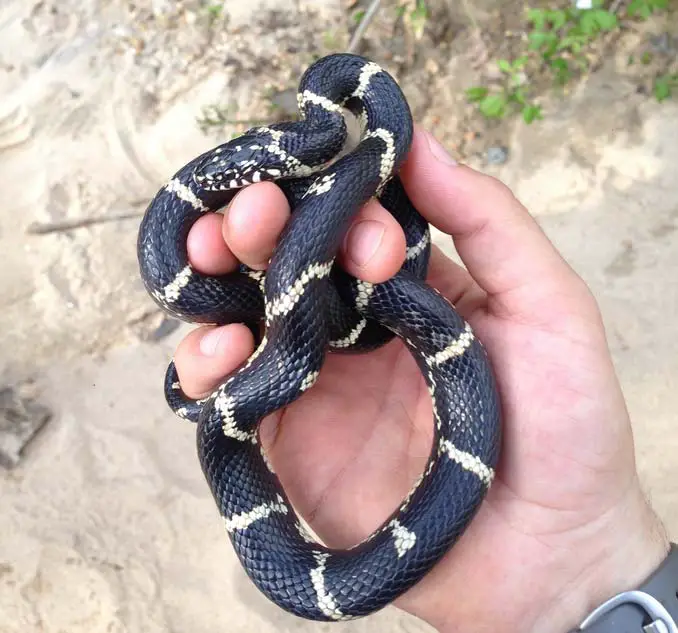
Once they are used to being handled, they are very tame and docile.
The older your snake becomes and the more you handle them, the calmer they’ll become. Their laidback temperament after maturation is one of their primary attraction to owners.
If their enclosure is set up right, you’ll see them engage in many of their natural behaviors. It’s not unusual to see a captive Eastern Kingsnake digging, basking, and even hunting.
You’ll know if your Kingsnake feels stressed or threatened when they engage in defensive behaviors. These include spraying musk, rattling their tail, and displaying quick, jerky movements.
Though not common, it’s also possible your snake may bite you. Hatchings and juveniles are more prone to biting than well-handled adults.
Eastern Kingsnakes are not venomous.
Don’t panic if your snake bites you. Trying to physically pull your snake off can hurt you and the snake.
Wait for them to naturally let go. If they don’t release, try pouring a tablespoon of water or vinegar over the area they’re biting.
In case that doesn’t work, you can also try the same method with mouthwash.
Once your snake releases you, thoroughly clean the wound with warm water and antiseptic soap. Flush any broken skin for several minutes and apply hydrogen peroxide to kill any bacteria.
Consult with your doctor or a primary physician if further medical attention is necessary.
When handling your snake, make sure to approach them slowly. Never shove your hands in their enclosure, try to snatch them, or otherwise rush the handling process.
Do not reach for them head-on. Instead, approach them from the side or back.
Slide your hand under the front third of their body to pick them up. Remember to support their body as you lift, using your other hand as needed.
If you’re worried about using your hands, snake hooks are a useful tool. Use a snake hook to initially pick up your snake and then transfer them.
Do not clench your Kingsnake or hold them too tightly. Your grip should be firm but relaxed.
Continue to handle your snake regularly. This will help them socialize and adjust to your presence.
For your and your snake’s health, make sure to wash your hands before and after handling sessions. Reptiles can carry Salmonella, so it’s always better to be safe than sorry.
Lifespan
With proper care, these hardy snakes can live up to 25 years old. Though 15 – 20 years is a more common lifespan, plenty of owners have reported their snakes making it to the 25-year mark.
Enclosure
Your Eastern Kingsnake will need a sizeable enclosure that grows with them.
Glass and acrylic tanks and vivariums are common enclosure choices, as are racks and plastic tubs.
If your enclosure has a mesh top, remember to add clamps. And in case your enclosure has front-opening doors, make sure to add a lock. This will prevent your Kingsnake from accidentally escaping.
Hatchlings and juveniles need at least a 10-gallon enclosure. Our recommendation for babies is 12 x 12 x 12 Exo Terra Glass Terrarium Kit.
Exo Terra Terrarium for Hatchlings & Juveniles
Once they reach their adult stage, their size will determine what enclosure you need. Snakes that grow to two feet will need at least a 20-gallon enclosure.
Similarly, snakes that grow over three feet will need 30 gallons. Kingsnakes that max out at four feet need at least 40 gallons.
Carolina Custom Cages Terrarium 36x18x24
Eastern Kingsnakes cannot cohabitate. Therefore, unless you’re breeding them, they should be kept as individuals at all times.
Besides being kept alone, the Eastern Kingsnake thrives best in enclosures that mimic their natural habitat.
They are terrestrial and do not climb trees or burrow into the substrate. Instead, they are found in wooded areas near water, such as forests and swamps.
This means that horizontal space is more important than height. If you have to choose, pick a longer enclosure instead of a taller one.
Their enclosure should have lots of hiding places and décor. They will appreciate stumps, logs, driftwood, and fake or live plants.
Substrate should be at least two inches thick. Aspen, coconut fiber, bark chips, and topsoil without perlite are all safe choices for substrate.
ReptiChip Premium Coconut Reptile Substrate
Avoid woods with a strong scent, such as pine and cedar. These can cause eye and respiratory issues.
For even more enrichment, you can also add sticks, leaf litter, bark, and similar substrate additions.
You’ll need at least three hides: one on the ‘hot’ side, one on the ‘cold’ side, and one in the middle.
Kingsnakes also need a water dish. It should be shallow but large enough for them to curl up and soak in.
Temperature & Lighting
Your snake’s enclosure will need a temperature gradient that ranges from 90°F on the ‘hot’ side to 75°F on the ‘cool’ side.
If you add a basking spot, it should be no hotter than 90°F.
You can create this gradient using heat lamps, a basking lamp, and under tank (UT) heaters.
Our recommendation is VIVOSUN Reptile Heating Pad with digital thermostat. It’s controlled by a digital thermostat so you can easily control the temperature.
VIVOSUN Reptile Heating Pad with Digital Thermostat
Never use heat rocks, since these are dangerous and can burn your snake.
All bulbs and lamps should be at least six inches away from the substrate. Similarly, UT heaters should be kept on the outside of the tank.
This prevents your Kingsnake from accidentally burning themselves.
If desired, you can create a more natural day-night cycle.
Automatic timers regulate the amount of time each type of light is on or off. It’s best to keep your snake on a consistent routine, so these are helpful for owners with a hectic or unpredictable schedule. Our recommendation is Zilla Digital Timer.
To mimic nighttime, you can buy a night bulb or turn your lamps off.
If you choose to buy a night bulb, pick one that’s blue or violet. Studies on snakes and other reptiles suggest that they can see red light just like daylight, preventing them from really resting.
If you choose to turn your lamps off, check to make sure the enclosure won’t drop lower than 5 – 10°F. No spot should be cooler than 65°F.
Your light cycle and temperature gradient should coordinate with a seasonal cycle, to an extent.
We say “to an extent” because it’s unlikely you’ll transform your snake’s enclosure to completely mimic each season.
Essentially, your Kingsnake should receive roughly 12 hours of daylight during the warm months (i.e., Summer and Spring). But in the cooler months (Winter and Fall), this should drop down to 10 hours.
If desired, you can also induce brumation. This is the equivalent of hibernation, but for cold-blooded animals and reptiles.
During brumation, your snake’s metabolism will drastically slow down. They’ll stop eating and become less active.
Some owners believe that inducing brumation is better for their Kingsnake since it more closely mimics what would happen in the wild.
Other owners prefer not to do this. Though they may slightly drop their snake’s enclosure temperatures during the cooler seasons, they won’t induce brumation.
Either way, there are no recorded adverse health effects. Eastern Kingsnakes that undergo brumation annually are just as healthy as their counterparts who stay active year-round.
Humidity
The Eastern Kingsnake enjoys humidity levels around 35 – 45%. However, this can be raised to approximately 60% during their shed cycles.
At least one of your hides should be kept humid in case your Kingsnake begins to shed without your knowledge.
These hides should be completely enclosed except for an entrance. They are typically smaller and should comfortably fit your snake when curled up.
Sphagnum moss is the substrate of choice to keep your hide humid. However, paper towels and washcloths will also work.
Galápagos Terrarium Sphagnum Moss
The humid hide should either be in the middle of your enclosure or on the ‘hot’ side.
Never place a humid hide on the ‘cold’ side.
High humidity levels and cooler temperatures can cause respiratory issues. If your snake is beginning to shed, this can cause unnecessary stress and compromise their health and shed cycle.
Diet
Potential owners are in luck, because the Eastern Kingsnake isn’t a picky eater.
In the wild, they eat birds and other reptiles, including lizards, frogs, salamander, and other snakes. They also hunt small mammals.
In captivity, they’ll readily accept live rodents or frozen and thawed rodents. They also do well with transitioning from live to thawed rodents, in case you start with live and want to transition later.
Live and frozen prey both have pros and cons.
Live prey may be more tempting to your snake, but can also fight back and harm them. There’s also a high chance of live prey transmitting diseases.
Frozen prey that’s been thawed may be less appetizing, but is safer for you and your snake.
Since Kingsnakes aren’t picky, it’s generally better to give them frozen prey.
To make rodents more appetizing, remove them from the freezer and thaw them overnight. Right before feeding, heat them up in a hot water bath or microwave.
In case your snake does seem reluctant to eat, there are two methods you can try.
You can add salmon or tuna juice, though doing this too often can make your snake reluctant to eat prey without it.
Or you can ‘brain’ the rodent by poking a hole in their skull using a pin or other sharp object. Then, squeeze some of the brain matter out.
As your Eastern Kingsnake grows, you can increase the size of the prey and decrease the feeding frequency.
Hatchlings will need to be fed at least once per week. Juveniles can handle being fed every week or every 10 days.
Adults can be fed every 10 days or every other week.
When feeding your snake, make sure the prey is no larger than the widest part of your Kingsnake.
After eating, your Kingsnake should have a bugle. However, their stomach shouldn’t be obscenely distended and the bulge shouldn’t last for longer than 12 hours.
If this happens, try switching to smaller prey size.
Never feed your snake without taking the proper precautions. This means always using tongs or another feeding utensil— never feed your snake using your bare hands.
If your snake regurgitates the food, remove it immediately.
If you use live prey and your snake doesn’t eat it within an hour, remove it. Even if they do eat the live prey, make sure to examine your snake for any injuries.
unlumm Feeding Tongs 15″ 2 Pcs
Don’t feed your Kingsnake if you induce brumation. They shouldn’t eat while dormant.
Even if you don’t induce brumation, it’s still possible that your Kingsnakes may have less of an appetite during the cooler seasons.
This is completely natural. Don’t panic if your Kingsnake decides they want to skip a meal.
Instead, simply try again in a few days or a week.
Your Kingsnake will need fresh water every day. While changing the water, check the dish to make sure no slime or algae has accumulated.
Potential Health Issues
There are several common diseases and health issues that affect Eastern Kingsnakes. These include respiratory infections, scale and mouth rot, mites, and inclusion body disease (IBD).
When you initially buy or adopt your Kingsnake, make sure to quarantine them for at least two weeks to make sure they’re healthy.
Keep an eye out for mites, which appear as moving black or red dots. They most often target a snake’s eyes, nose, and mouth.
Properly setting up your enclosure will help prevent environment-related issues. For example, using the proper substrate keeps your snake from suffering from respiratory issues.
Keeping your enclosure clean is just as important.
Spot clean your enclosure every other day. Perform a deep clean and change the substrate at least once per month.
You should also periodically clean your décor, hides, and water dishes.
This prevents diseases related to poor living conditions, such as scale rot.
Unfortunately, some health issues can’t be cured. IBD is the most prominent example of this.
IBD is a highly contagious virus that affects captive-bred boas and pythons. One study in 2020 found that it impacted 16.5% of the snakes in the sample size.
This disease is transmitted by blood, usually through carriers like mites.
Symptoms appear as snakes mature and become progressively worse. They include ‘stargazing’, loss of balance, and muscle twisting/ contractions.
Affected snakes must eventually be humanely euthanized.
Engaging in preventative care like regular vet visits also helps keep your snake happy and healthy. Call the local vet practices and find out which ones have a vet that’s qualified to care for exotics and reptiles.
Schedule an appointment for your Kingsnake at least once per year or whenever you suspect they may be ill.
Excessive soaking, irritation and restlessness, swelling or discharge, and a loss in appetite are all signs that your snake may not be feeling well.
Watch your snake’s feeding schedule, bowel movements, and activity levels. Any drastic or extended changes in their regular routine is also a sign that you should contact your vet.
Breeding
The only time your Eastern Kingsnake should be in the presence of another Kingsnake is during breeding.
Females should be at least two years old before you mate them. It’s at this point that they reach sexual maturity; mating them beforehand can cause health issues.
To sex your Kingsnakes, you’ll have to use the probing method. This involves inserting a thin rod (a snake probe) into your Kingsnake’s cloacal vent.
The probe can be inserted more deeply in males.
In addition to this, probing causes females to drop roughly one to three scales. But males drop an average of nine to 15 scales.
It’s best for experienced owners and vets to perform this method. New owners or beginner breeders may accidentally harm their snake during this process or cause undue stress.

As with most animals, including reptiles, mating and breeding occurs during the Spring season.
To trigger mating, you may need to induce brumation. Though this can be daunting for beginner breeders, cooler temperatures are necessary.
Fall and Winter will trigger sperm production in males and prepare females for ovulation.
However, you may be in luck if you’re worried about this process. Some owners have reported that simply lowering the enclosure temperatures for a short period of time is just as effective.
This essentially mimics the cooler seasons without actually causing brumation.
When your Kingsnakes mate, the male will bite the female’s neck and twist around her. They may writhe around; while this can look alarming, it’s completely natural.
Do not interfere during the mating process unless one or both of your snakes are in immediate danger.
If the mating is successful, it will take roughly 30 – 50 days for the female to lay eggs. Typically, female Eastern Kingsnakes lays one or two clutches, each containing anywhere from 10 to more than 20 eggs.
The eggs will incubate for approximately 70 days before hatching.
Hatchlings are independent as soon as they leave the egg and require no parental care. If you haven’t already done so, remove your hatchlings to separate enclosures to prevent injury.
Conclusion
Though the Eastern Kingsnake can be initially unfriendly as a hatchling, regular handling quickly turns this snake into a docile juvenile and adult.
Whether new or experienced in the snake trade, owners will be delighted with their snake’s temperament and high activity level during the day.
They handle well, eat readily, and have straightforward care requirements. In addition to this, they are beautiful and hardy.
When faced with a multitude of benefits, it’s no wonder the Eastern Kingsnake is increasingly considered one of the best reptiles for all owners.
Related:

